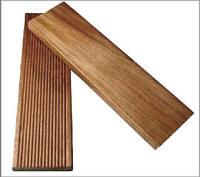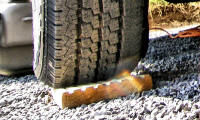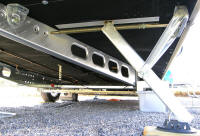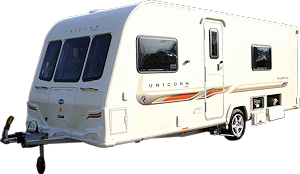A topic that can cause lots of disagreement and
different methods, but never the less important. These are my thoughts
and what I do after 45 years of caravanning. (doesn't mean I am right!)
Why level the van accurately (well fairly)
Some people just seem to turn up on site, put the steadies
down and get on with things, not bothering with levelling so why bother?
To enable the Fridge to work efficiently it needs to be reasonably level
to allow the refrigeration system to work.
To stop things rolling about in the caravan, including yourselves in
bed, and so that doors don't swing open/shut and the sinks and shower
drain properly the van needs to be level front to back and side to side.
To check the level I use a 9in small spirit level.
 I check the van for level placing it on the bottom of the door frame for
front to back and on the floor just inside the door for side to side.
I check the van for level placing it on the bottom of the door frame for
front to back and on the floor just inside the door for side to side.
Side to side levelling
Levelling ramps
I have two types of levelling ramps as shown below. The simple ramp A
and the stepped ramp B

Both work well. There are two methods of using them, many people reverse
on to them until the van is level, then un-hitch, but as the car was
reversing the van the coupling was being pushed in and this makes the
van difficult to in-hitch. If you pull the car onto the ramp it is
easier to unhitch. When the van is level and before applying the hand
brake and un-hitching some people put a wheel chock in place to stop the
van rolling down the slope. This is less needed when using the stepped
leveller.
If you have a motor mover you can un-hitch and use the mover to move
into position on the ramps.
Whilst these ramps are fairly simple to use they can be difficult to
position if you are trying to level the van and align an Al-Ko wheel
lock at the same time.
Other methods
If you are on a gravel hard standing you could 'shift' some of the
gravel in front of the wheel to be LOWERED and move the van into this
depression.

At a local CL I regularly do this and it allows me to level by about
1.5in and easily position the wheel for the lock. Obviously I smooth the
gravel out when leaving and only do this on a suitable pitch. I
certainly don't advocate doing this on any other type of pitch.
Levelling planks

Since the advent of the Al-ko wheel lock and the need to be able to
position the van for it after levelling I have fallen back on my old
levelling method, wooden planks. I use Decking, this is readily
available, already treated and the correct width for tyres. I already
use this in 9in lengths to go under my steadies to spread the load. So,
I cut three 2ft lengths, and use these, stacked if required, to raise
the wheel to the required height and can then move forward or backward
to align the wheel lock. Since doing this I don't bother carrying
my levelling ramps.

Front to back levelling can now be carried out using the jockey wheel.
If you can't achieve a level because it has run out of adjustment. I
wind down the front steadies, and release the jockey wheel clamp, wind
the wheel in or out as required, re-clamp it, lift the front steadies
and continue adjusting until level.
Now you can lower all the steadies.
Steadies
As the name suggests, steadies are there to steady the
caravan when people get inside it. Without them down, as people move
inside it ,say towards the back, it will eventually tip back with the
front in the air just as some of my friends found out recently at a
Dealers whilst looking at a display caravan that didn't have the rear
steadies down. The steadies are not there to support the weight of the
caravan and certainly not there to level it from side to side.
The photo below shows a fairly typical front steady. You will notice it
is mounted onto the floor not the chassis. So any lifting force is to
the floor at the corner.

When winding steadies down the idea is to wind them down so that they
firmly support that corner, not to wind them down as hard as you can.
Achieving this takes a bit of practice, you can feel the increased
resistance on the steady winder as the steady starts to take a load.
Carefully watching the van you will see it starting to lift slightly. It
is at this point that the steady is correctly adjusted. After levelling
with the jockey wheel I always wind the rear steadies down first.
When using a drill with a socket to wind down the steadies you cannot
feel the resistance, so I use a drill with an adjustable torque setting
that does not over tighten. I always go round with a hand steady winder
after we have settled in the van to check their tightness as say taking
the awning out of the van will have changed the loading on the
suspension and the loading at the steadies.
Spreading the load at the steadies.
As most vans are supplied, the foot of the steady is fairly small and
will easily sink into soft ground. Many people fit 'pads' to the
steadies to spread the load, or use say pieces of wood to do this. As
you will see in the picture below, I sometimes use both!

On sloping sites, either the front or back steadies may be wound down a
long way or not even reach the ground. Steadies should not really be
used wound down a lot as their 'steadying' reduces. One way to stop this
is to place blocks underneath, or even bricks/stones as provided by one
Site that I stayed at recently.

During the stay
JTQ from the Caravan Talk Forum comments:
"The
caravan wheels ought to carry almost all the van's and occupant's
weight, the steadies just steadying the thing tipping. On soft ground
these wheel loads can and do lead to the tyres sinking into the ground.
This then can place far too much load on the steadies as the weight is
transferred onto them, more like a beam supported at its far ends. The
first hint most get is the van seems to bounce as you move around as the
structure springs between its higher loaded ends. So on soft ground ease
and re-adjust the steadies occasionally. This will save undue stresses
in the bodywork and things will be more comfortable".
Jockey Wheel: up or down?
This is a question that causes great reaction on the
Caravan Forums when asked. This is my thinking on it.
A jockey wheel when down and the steadies up will carry a loading of
70-90Kg depending on the nose weight of your caravan. If you wind up the
jockey wheel after levelling and putting the steadies down, this will
increase the loading on the front steadies by say 35Kg each. Now as
stated before, on a lot of vans these steadies are mounted on the floor
not the chassis. I can see no logic in doing this as I feel the jockey
wheel, through the chassis, is helping to distribute the weight. Leaving
the jockey wheel down does not damage it or wear it out, so why not. I
know the steadies are rated high enough to take this load, but why
stress the floor at the front corners unnecessarily?
|
